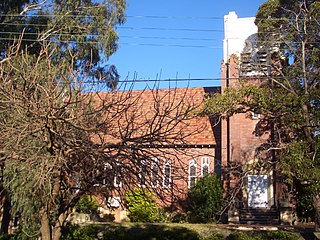
Peter Dodds McCormick was an Australian schoolteacher and songwriter, known for composing the Australian national anthem, "Advance Australia Fair". He published under the pseudonym Amicus, Latin for "friend".

St James' Church, commonly known as St James', King Street, is an Australian heritage-listed Anglican parish church located at 173 King Street, in the Sydney central business district in New South Wales. Consecrated in February 1824 and named in honour of St James the Great, it became a parish church in 1835. Designed in the style of a Georgian town church by the transported convict architect Francis Greenway during the governorship of Lachlan Macquarie, St James' is part of the historical precinct of Macquarie Street which includes other early colonial era buildings such as the World Heritage listed Hyde Park Barracks.

St John the Baptist Anglican Church is an active Anglican church located between Alt and Bland Streets, Ashfield, a suburb of Sydney, New South Wales, Australia. Founded in 1840, on land donated by Elizabeth Underwood, the church building is the oldest authenticated surviving building in Ashfield, having been built at the time when subdivision increased the population density sufficiently to turn Ashfield into a town. It was also the first church built along the Parramatta Road which linked the early colonial towns of Sydney and Parramatta. The earliest remaining parts of the building are one of the first Sydney designs by the colonial architect Edmund Blacket, who later became renowned for his ecclesiastical architecture.

St Andrew's Presbyterian Church is a Presbyterian church at 32 Moon Street, Wingham, New South Wales, Australia. Together with St Thomas' Presbyterian Church, Krambach, the St Andrew's congregation forms part of the Wingham and Upper Manning Parish.

Sir John Sulman was an Australian architect. Born in Greenwich, England, he emigrated to Sydney in 1885. From 1921 to 1924 he was chairman of the Federal Capital Advisory Committee and influenced the development of Canberra.

Allora is a rural town and locality in the Southern Downs Region, Queensland, Australia. In the 2021 census, the locality of Allora had a population of 1,205.

Thomas Rowe was a British-born architect, builder and goldminer who became one of Australia's leading architects of the Victorian era. He was also a politician, who was the first Mayor of Manly.

The Sydney Town Hall Grand Organ is a large pipe organ built by English firm William Hill & Son in 1890. It is located in the Centennial Hall of Sydney Town Hall in Sydney, New South Wales, Australia.

City Congregational Church was a church building of the Congregational Church at 407 Adelaide Street, Brisbane, Queensland, Australia, which replaced the Wharf Street Congregational Church, Brisbane.

St Andrew's Anglican Church, Roseville is an active Anglican church on the corner of Bancroft Avenue and Hill Street in Roseville, New South Wales, Australia. It is part of the Diocese of Sydney.
Emmeline Mary Dogherty Woolley, commonly referred to as E. M. Woolley, was an English-born Australian pianist, organist and composer.

John Frazer was an Irish-born Australian politician and businessman.

Scots Presbyterian Church is a Presbyterian church located at 90 South Terrace, on the corner of Parry Street, in Fremantle, Western Australia. It was the first Presbyterian Church built in Fremantle and one of only six to decline amalgamation with the Uniting Church.
Dr. Robert Dalley-Scarlett was an Australian organist, choirmaster, composer and musicologist.

Lindsay Gordon Scott ARAIA was a prominent Sydney architect best associated for his design of the Erskineville Town Hall and numerous surf pavilions in New South Wales, including several on the Northern Beaches of Sydney.
Brighton College was a non-denominational day and boarding private girls' school in Manly, New South Wales, Australia. It operated from 1889 to 1960 in the suburb of Manly, Australia.
Arthur John Mason was an Australian organist and journalist, remembered as Sydney City Organist from 1901 to 1907, when he moved to London as correspondent for the Sydney Morning Herald. He was a son of George Birkbeck Mason, musician and entrepreneur, and grandson of Abraham John Mason, wood engraver of London and New York.
Joseph Richard Massey, referred to in his lifetime as Joseph Massey sen., was an Australian musician and founder of a family of musicians, best known as church organists.
Thomas Sharp MCO, was an organist in Launceston and Sydney, Australia, remembered as a member of the committee which drew up the specifications for the Grand Organ in Sydney Town Hall. He was the only dissenter from its final decision. Three of his sons were professional organists.
Frederick Morley was an organist and music teacher in Sydney, Australia. He achieved a reputation as organ architect, creating tables of specifications by which many of Sydney's pipe organs were built.















